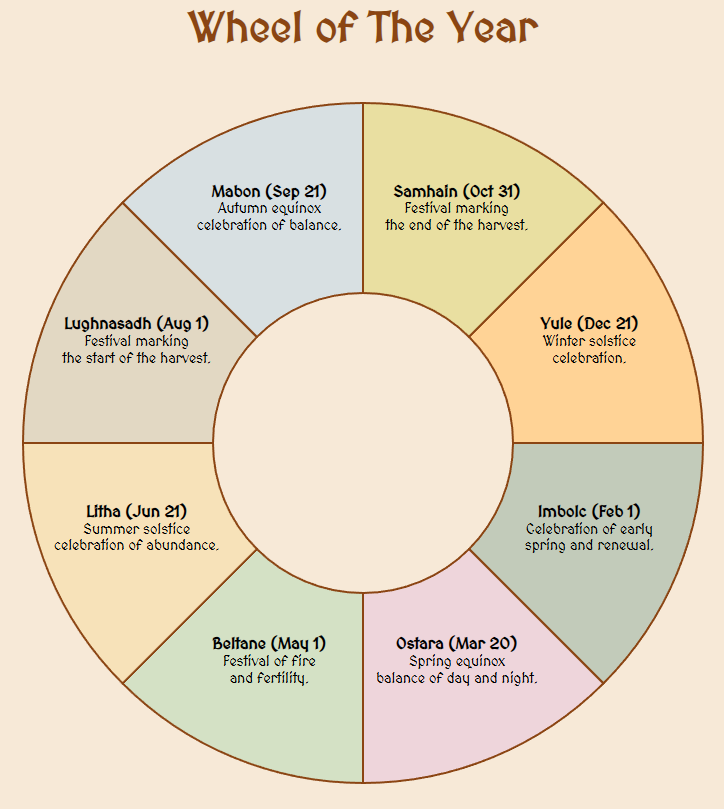Wheel of the Year: A Celebration of Seasons and Cycles
The "Wheel of the Year" is a term prevalent within Pagan and Wiccan communities as a means of describing and understanding the annual cycle of the layering seasons, together with their corresponding festivals. The wheel is not only symbolic of the passing of time but also of the cyclic nature of life’s perennial phases, reflecting the rhythm of life, death, and rebirth.
 The structure of the Wheel of the Year is based on the agrarian cycle in ancient times and includes eight significant points, namely, four solar points (two solstices and two equinoxes) and four seasonal points marking traditional agricultural points.
The structure of the Wheel of the Year is based on the agrarian cycle in ancient times and includes eight significant points, namely, four solar points (two solstices and two equinoxes) and four seasonal points marking traditional agricultural points.
The solar points are broadly recognized across most traditions and cultures, signifying astronomically important junctures. The Winter Solstice, also known as Yule, is the shortest day of the year and marks the return of the light. The Spring Equinox, or Ostara, represents the point of perfect equilibrium, where day and night are of equal length. The Summer Solstice, or Litha, is the longest day of the year, celebrated as a time of abundance and power. The Autumn Equinox, also known as Mabon, again, represents another point of balance and marks the start of the harvest season.
The seasonal points are rooted more in Celtic tradition. They are Imbolc, marking early spring and the first signs of life; Beltane, marking the beginning of summer and festivity of life; Lughnasadh, marking the beginning of the harvest season, and Samhain, signaling the descent into winter and a time of remembrance for those who passed.
For followers of these paths, each point on the Wheel of the Year is a time to reflect, celebrate, and embrace the unique energy and spiritual implications of that period. These celebrations often involve rituals and ceremonies designed to align with the natural rhythms and harness their energy positively.
These festivals connect practitioners more deeply to the natural world, the wheel of the year offering them time to reflect on personal growth and spiritual progress. The Wheel of the Year reminds believers of their place in the natural world and the cyclic nature of all existence. Each turn of the wheel marks another notch in the journey of life, reminding us to be present, grateful, and in tune with the cycles of life.
Take, for example, the celebration of Beltane (early May), which symbolizes vitality, growth, and abundance. Fertility rituals, fire ceremonies, wheel of the year and Maypole dances are common practices during this festival. Similarly, Samhain is not only a celebration of the end of the harvest but also a time to honor the dead and contemplate the journey beyond physical life.
Despite its rootedness in ancient traditions, the relevance of the Wheel of the Year persists into contemporary times. Its profound message speaks to the primal human connection to nature and the cycles of life. With its emphasis on balance, rhythm, and seasonal harmony, the Wheel of the Year offers not just structure but also spiritual insight and wisdom. By understanding and respecting these cycles, one can achieve a stronger, pagan wheel of the year more profound connection to the world and its natural rhythms.
In essence, the Wheel of the Year communicates that life is a never-ending circle of growth, harvest, death, and rebirth, an eternal cycle we all partake in. By recognizing and celebrating these stages, we can live more in harmony with nature and ourselves.
 The structure of the Wheel of the Year is based on the agrarian cycle in ancient times and includes eight significant points, namely, four solar points (two solstices and two equinoxes) and four seasonal points marking traditional agricultural points.
The structure of the Wheel of the Year is based on the agrarian cycle in ancient times and includes eight significant points, namely, four solar points (two solstices and two equinoxes) and four seasonal points marking traditional agricultural points.